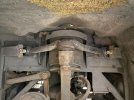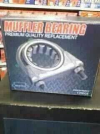- Joined
- Mar 2, 2005
- Messages
- 15,241
- Location
- Southeast Tennessee
- Display Name
Display name:
This page intentionally left blank
I’d love to see some interior shots when you get a chance.
I’d love to see some interior shots when you get a chance.
What does your Aux air feed?
Sent from my SM-N970U using Tapatalk
Sorry to hear about the engine, but the rest looks great.
WOW! Ted, that is quite the piece of equipment, y'all will certainly be able to tour the county in style and comfort. Thanks for the video(s), always find them entertaining and fun. The complexity of an RV of that size is amazing, but if anyone can handle it, I'm confident it is you!
WOW! Ted, that is quite the piece of equipment, y'all will certainly be able to tour the county in style and comfort. Thanks for the video(s), always find them entertaining and fun. The complexity of an RV of that size is amazing, but if anyone can handle it, I'm confident it is you!

That ifs is interesting. Didn't know that was a thing.I've gotten a bit of time in to work on the bus. Everything is slower going just because it's the first time I'm having to look at, think about, and do everything.
I got new air fittings and got the rear 6 airbags back in and together. They appear to be leak-free.
Once I had the new rear bags in, I was able to attack the driveshaft the way I had planned. I rotated the driveshaft input so that the U-joint was straight up and down with the rear wheels off the ground, then put them on the ground and had the airbags aired up. I put the bottle jack underneath the good side, put a socket on it, and pushed upwards. The U-joint came out with that without too much difficulty at that point. It looks like I need to clean up the inner surface. Somewhere in this bus's recent history, it hit a deer. When you tow one of these busses the driveshaft has to get removed, or at least disconnected from the differential and then tied up and out of the way. My guess is when it hit the deer it got towed in, and the tow truck driver messed up the re-installation of the driveshaft. Fortunately I'm not seeing any leaks at the differential input yoke and the bearing feels fine. Before I go to put the new driveshaft in I'll get the rear wheels off the ground and spin it a few revolutions just to make further sure.
I got the old muffler out and started looking at how I want to install the new one. Should be simple enough, just have to make up the brackets how I want them.
Moving to the front of the bus, the air springs are not set up in such a way that they're easy to change:
View attachment 123102
People complain about the IFS for this reason. The airbag can actually get out through the control arm once the suspension is in the full down position (at least according to the forums) but it's not as simple and straightforward as the rear ones. The single nut on the top will need a wrench to just barely get at it, and then the air fittings on it are also a bit convoluted. So I'll get them, but it's not super fun. What's annoying with this is that the upper control arm was obviously replaced (that's a good thing) but when it was replaced they obviously left the original airbag there. That's the kind of thing that's annoying to me when I see it. I may tend to go overboard with "while I'm there" things, but for the low cost of airbags and how much easier it would make the job, it just seems silly to have not done it then.
But another interesting thing I found upon looking at the airbags up there is that the ones Prevost sent me were different. So my first question was whether I got the right ones. Doing some digging into the part numbers and seeing some forum posts, Prevost came up with a new front airbag that they are selling as "optional" but upgraded. It's 1" larger in diameter, which (similar to some of my other tire projects) means that it can support the same weight at a lower PSI. Aside from this theoretically making the ride more comfortable, the main reason for it is that people were complaining with the front airbags on the IFS not doing the best job of supporting the bus. Basically since they require a higher PSI to support the same weight, that PSI gets too close to the operating PSI of the air system and it gets harder to keep up. So, aside from replacing cracked springs, it's an upgrade.
And yes, my sway bar bushings need to be replaced.
The good news is that overall (at least on this side, I haven't gotten the driver's side wheel off yet) it looks as though the major components known to need replacement around 100k have been done already.
While up front I started going through and greasing all the zerk fittings. I also found a grease cap for the idler arm on the steering had fallen off and was just sitting below the idler arm on the bus. I have no idea when this would've happened. I can't imagine it would've made much of the drive home like that, but who knows. It's loose in there so I'll have to do some effort to make it fit a bit snugger.
That ifs is interesting. Didn't know that was a thing.
I got the old muffler out

The muffler bearings?This is very important....how did the bearings look.??
Yes. In bigger RVs it is very important to maintain the muffler bearings. These diesel engines produce so much torque that the muffler needs to be able to wiggle under hard acceleration and deceleration. Otherwise with worn muffler bearings the torque is transmitted to the engine mounts which can become weak and break at the worst possible time, like on the interstate in heavy traffic.The muffler bearings?

Not knowing much about diesel engines of that size, but what is it that makes you want more power (aside from the Tim Allen in all of us)? Would changing the gear ratio a bit be a better solution if acceleration or mountain passes are the desire, at the expense of a bit of hwy fuel mileage? Obviously those diesel engines are designed to cruise in a narrow part of the RPM band, so gearing changes would be pretty limited.
Ted, you make me chuckle. In a good way.
So, is the high idle used to keep the batteries charged and the air system pressurized? Back when I was young and was on tour busses the driver always kicked it to high idle when the bus was parked and running.
Yes, I know. I lived in my 5th wheel for 2 years when I first moved to Gallup.High idle will keep the air pump and alternator going stronger, so that does help keep all those systems at full capacity and also helps with filling the air tanks from a cold start faster.

Yes, I know. I lived in my 5th wheel for 2 years when I first moved to Gallup.
Seemed like everytime I got home from a flight at around 0530, I would find a diesel Rv parked next to me. As soon as I fell asleep, that diesel would start up at high idle...to soon be followed by every diesel in the Rv park. Constant high idle until about 10am or so...
So that makes no sense to do unless they were leaving, or were reliant upon engine heat for the interior (which they shouldn't be).

While your RV/bus is amazing, and as much as I would love to live that lifestyle, I could never do it without a mechanic on staff (and traveling with me).
I pretty much need to call an electrician to change a light bulb.
